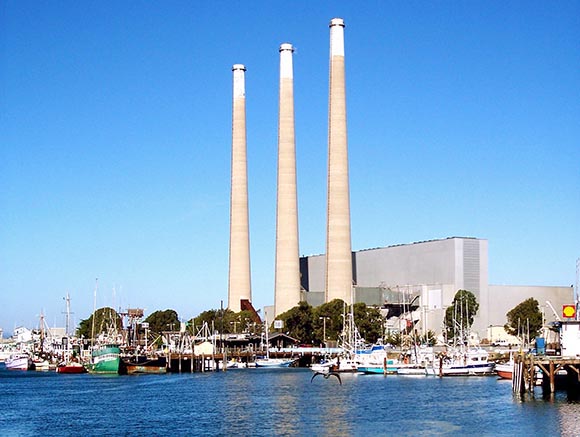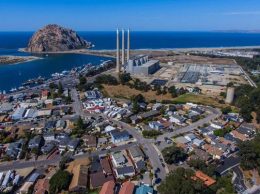
The exhaust stacks of the Dynegy Power Plant, stand over Morro Bay. On Feb. 24 the Houston-based company withdrew its offer to sell the site, along with plants in Oakland and Moss Landing. (Courtesy photo)
In the quiet and foggy coastal town of Morro Bay, the community and local officials are dialing up economic development efforts.
With about 10,000 residents, the small commercial fishing and tourism-driven community is charting a new path for growth and more diversified revenue streams.
City councilmember Christine Johnson is just one of many individuals championing a new game plan for the city.
“We really have no revenue sources other than our tourism,” Johnson said. “The [tourism business improvement district] is doing well, but sales tax is flat and there’s only so much property tax we collect. We can’t rely too much on [tourism dollars] alone.”
Johnson said Morro Bay is depending on an old economy and old ways of operating.
“We have a 30-year-old general plan that we have to update,” she said. “Our question is how is this small coastal city going to sustain [itself] for the next 50 years. What’s the right kind of development for us?”
Over the last half-century, the city has relied on just a few industries and $525,000 in annual payments from power plant operators Dynegy, to keep above water. However, those payments stopped after the company decommissioned the natural-gas-burning plant last year. Dynegy had planned to sell the Morro Bay plant along with two other California holdings, but in an earnings release on Feb. 24 the company announced it was canceling the sale process. Bids for the Texas-based company’s portfolio were below expectations, according to a release.
While city officials were eager to work closely with a new owner on a redevelopment project for the massive site, which also claims about 100 acres of oceanfront property, those hopes have been put on hold — for now.
A redevelopment of the site would be a huge boost to the city, as the coastal property holds lucrative development potential and growth from expansion through annexation isn’t really an option, according to those the Business Times spoke with.
Still, city officials and local business leaders are moving forward with a plan that builds on assets more within Morro Bays’ control.
The city doesn’t have an economic development director who is spearheading new programs and while that isn’t uncommon for cities of Morro Bay’s size, it does create a need for a high level of coordination between stakeholders. To manage that process, the city hired consulting firm Don Maruska & Co. last year.
Since then, company CEO Don Maruska has led the effort to implement Morro Bay’s Local Economic Action Plan, or LEAP. The first phase of establishing the program’s framework is complete. Some goals include leveraging existing environmental assets, revitalizing and linking existing business districts, assessing fiber optic connectivity opportunities and enhancing business attraction efforts. Action groups representing 12 different areas of the plan are currently gathering research and putting together proposals for policies, funding and other resources all set to go before the city council on March 24.
“LEAP is motivated in part by realizing that the city can’t rely on power plant and tourism revenues, and how can we strengthen and diversify the local economy to be sustainable into the future,” Maruska said. “This has been a reality that people have been aware of for a while, and that’s why there is this impetus for action.”
Maruska said a big focus for the city is how to lay the groundwork for more head-of-household jobs, and the fact that no attractive offers were put up for the power plant “really underscores the idea that Morro Bay needs to look at new opportunities to sustain itself.”
One of those opportunities is the Transpacific fiber optic cables that run right through the city’s “back door,” as Maruska put it.
Local fishermen originally fought the billion-dollar business consortiums that wanted to build landing points for as many as 32 cables but lost. The cables, which run along the ocean floor, are communications and Internet links to Australia, New Zealand and Asia and are viewed as an untapped avenue for attracting tech companies, satellite offices of established firms or startups. The city is currently pushing to upgrade it broadband capabilities as well.
“The tourism economy has been doing well so numbers are strong, but that’s clearly not enough anymore,” said Mike Manchak, president and CEO of the San Luis Obispo County Economic Vitality Corp. “I think this is going to be the perfect case study about what a small city should do to refine its focus.”
The opportunity for Morro Bay is perfect right now, Manchak said, but it’s unclear how long that window will stay open.
As for Dynegy and the fate of the power plant property, the city could, after 20 years, buy it back for $1, thanks to a clause in current deed that requires the power plant to sell or produce electricity. Until then, Morro Bay will just have to wait it out, though in a Feb. 24 city council meeting, Councilman John Headding said the city needs to get a plan together and make a proposal to the company as soon as possible. Headding proposed getting nonprofits such as the Trust for Public Land and similar conservation organizations involved because since they hold pipelines to cash.
“Dynegy is fully intending to exit California and at some point the city is the land use authority on that site. We want to be able to help shape that,” said Morro Bay Mayor and former Dynegy power plant employee Jamie Irons. “Now it’s just a matter of who’s going to be the new owners. We’re here to meet and talk and engage in conversation on the opportunity.”






 Print
Print Email
Email
















